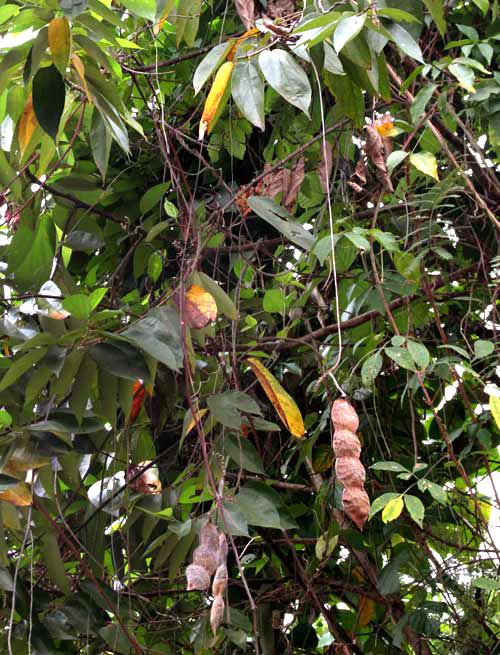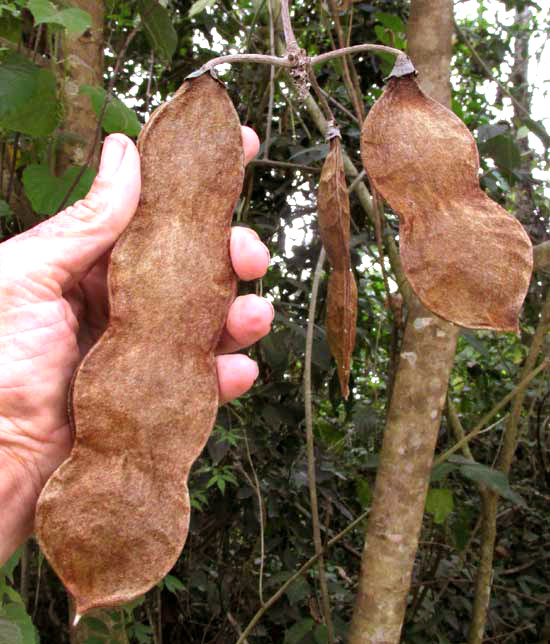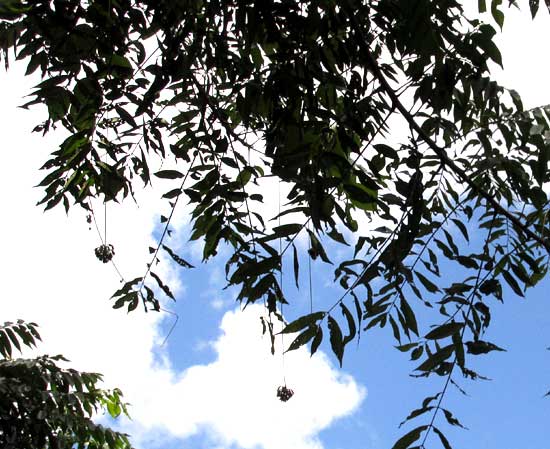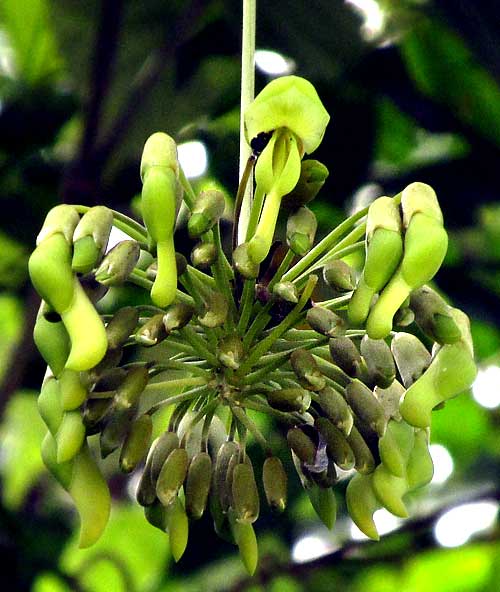Excerpts from Jim Conrad's
Naturalist Newsletter
from the May 1, 2016 Newsletter with notes from a visit to Lacanja Chansayab in the Lacandon Reserve; elevation 200m (650ft), N16.604°, W90.917°; Chiapas, MÉXICO
PICA-PICA
On April 14th as I hiked small gravel backroads around Lacanja Chansayab in Chiapas's Lacandon Reserve, one of the most eye-catching roadside plants was a dry-season-leafless vine whose foot-long pods hang on long peduncles from trees, as shown below:

Below, you can better judge how large those pods are in a close-up of one in my hand:

At the very moment the above picture was snapped, behind me on the road a little Lacandon girl seemed to materialize out of nowhere, saying ""You shouldn't touch that, because it has tiny, sharp hairs that come off, stick into your skin and won't come out, so that you'll itch a lot." She's on the right, beside her little sister, at www.backyardnature.net/n/16/160424le.jpg
As soon as I heard this I realized what kind of plant we had. It's a viny member of the Bean Family, so the big fruits are legumes. Moreover, it's the genus Mucuna, whose various species often go by the name of Pica-Pica, the name based on the Spanish verb picar, of which one meaning is "to prick," as in "stick into your skin," as the little girl said. Around the hut at Hacienda Chichen in the Yucatan there lots of prickly Pica-Pica legumes hang from the trees and I'm always having to tell tourists not to touch them. I didn't recognize these Chiapan Pica-Pica legumes because they're old with most of the hairs fallen off, and they're so big. You can see the four-inch-long (10 cm) Pica-Pica pods I'm used to -- and Pica-Pica hairs sticking into my skin -- at the bottom of our Pica-Pica page at www.backyardnature.net/yucatan/mucuna-p.htm
This big-podded Pica-Pica is MUCUNA ARGYROPHYLLA, distributed from southern Mexico -- except in the arid Yucatan -- south to Guatemala and El Salvador. It favors humid forests and disturbed areas where its woody stems climb into the tops of tall trees, sometimes covering them, like Kudzu in the US Southeast. Pica-Pica leaves are trifoliate and in fact look a bit like Kudzu leaves.
Because of its weediness, irritating (but not stinging) hairs, and reports of cattle getting sick from eating its leaves, this Pica-Pica isn't much appreciated by country folks, except those taking advantage of traditional medicine.
For the online Biblioteca Digital de la Medicina Tradicional Mexicana reports that the vine's big seeds, which are a little similar to a human eye, are used to protect against the evil eye, which seems to afflict an amazing number of backcountry folks. For hemorrhoids, you need a "male" seed and a "female"one -- a concept fundamentally at odds with Western botanical concepts. To determine which seeds are of which sex, put them into water. Males float while females sink.
from the October 26, 2018 Newsletter with notes from a camping trip into northern Guatemala's Petén department
PICA-PICA FLOWERING
During my recent camping trip south, on October 2 as I hiked along the highway running through El Rosario National Park, on Sayaxaché's east side in northern Guatemala's Petén department, some items dangling from a tree, on long, slender, stringlike things, caught my attention. They're shown below:

The dangling items were too high up to show any details, but the camera's telephoto lens revealed what's shown below:

So, it's a dense cluster of flowers, with only one blossom fully open, but that one flower with its expanded upper petal (the standard), two side petals (the wings) and with its two lower petals fused together along their common borders to form a scoop-like structure (the keel), the plant producing the cluster reveals itself as a member of the gigantic Bean Family, the Fabaceae.
In 2016, in neighboring Chiapas, southern Mexico, we encountered very large legumes covered with irritating hairs dangling on similarly long, slender peduncles. That was Pica-Pica, Mucuna argyrophylla, so could this possibly be the cluster of flowers that proceeds that species's fruits?
Many plants bearing stinging or irritating hairs are called Pica-Pica, because the name says that the plant "pricks" or stabs you, and lots of plants do that. However, Mucuna argyrophylla is endemic only to southern Mexico (not in the arid Yucatan), Guatemala and El Salvador. As such, on the Internet I couldn't find good pictures of the species's Mucuna argyrophylla. However, there was a word description of them, listing these features:
# calyx with short, blunt or rounded lobes
# calyx "silky" with dense, slender, closely held hairs
# flower greenish, yellow or tinted with lavender
# flower's wings as long as the standard, but the keel much longer
# keel rounded at its apex
Our flowers match this description perfectly, plus there just aren't that many Bean Family vines producing flowers and fruits on such long-dangling peduncles, so even without seeing a Mucuna argyrophylla blossom, I'm pretty sure that that's what we have here. Also, there's no reason for it not to be Mucuna argyrophylla, since that species commonly occurs throughout its limited distribution, and the Petén is in the center of its distribution area, and we were in the right habitat.
Flowers in the genus Mucuna usually are pollinated by bats.
Traditionally an excellent black pigment used to paint handicraft was made by mixing an extract from Mucuna argyrophylla seeds with alum and crushed insects called aijshi, whose formal name I can't find on the Internet. Several Internet pages say that the "scales" of aijshi are used, but I think that that must be an error. In southern Mexico scale-like cochineal bugs on pricklypear cacti traditionally were farmed to produce an exceptionally bright red dye, so I bet that that's what they're talking about. Our page on cochineal bugs is at www.backyardnature.net/n/a/cochinea.htm